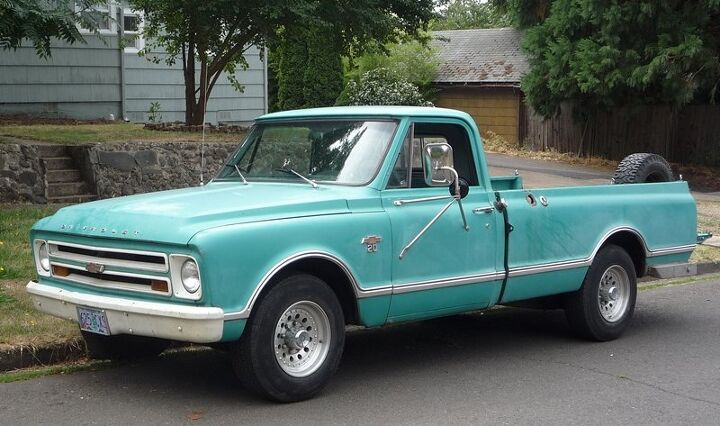Curbside Classic: 1967 Chevrolet C20 Pickup

Here’s a mighty fine example of one of my all-time favorite trucks, hard at work on the job site. It probably won’t come as a great surprise to you that there a dozens of these vintage Chevy trucks still earning their keep hereabouts, but this is a particularly nice one. And for some reason, the first year ’67s aren’t that common. Although I’m quite fond of my ’66 F-100, I’m not very partisan when it comes to American trucks of this vintage: they’re all just about equally attractive, hard working and easy to keep running. I’d take this turquoise beauty in a heartbeat (of America).
I should qualify that. When it comes to Chevy trucks, my love for the pre-’67s doesn’t extend to actually wanting one, for one big reason: wood bed floors. Yup, this truck here is the first Chevy to have a steel floor, something Ford went to quite some years earlier. Although Oregon’s climate is fairly gentle on steel, its long gray and wet winters are a breeding ground for those critters that live on wood, turning it to pulp. That reminds me, my utility trailer’s floor is going quickly this year.
And if I remember correctly, the floors on the Stepside beds of this vintage Chevy still had the wood planks. But not this nice 8′ Fleetside, which is why it’s here. By the way, there’s no doubt this is a ’67, because of the lack of side marker lights and that small rear window, which quickly disappeared. It looks like they must have had some left over or something.
This generation Chevy truck was built through 1972. There were three distinct groupings: the ’67 and ’68; the ’69-70; and the ’71-’72. The clean eggcrate grille of the ’71-’72 is hard to beat for its classic good looks; maybe the best looking truck ever. The 1973 model that replaced them was seemingly made forever, but its cab was distinctly plasticized, compared to the all-steel interior of this generation. Thanks, but no thanks to the ’73 and up.
Of course, Chevy power was one of the draws of these trucks, in addition to their handsome new styling. A full palette was on tap: the standard 250 six (155 gross hp); and the optional long-stroke, high torque 292 six (170 hp). V8s were still still limited to small blocks in 1967; in ’68 the 396 came on board. The truck V8s were detuned: the 283 V8 had 175 hp, the 327 had 220 hp.
What’s interesting to note is that pickups were going through a rapid change in terms of power right about this time, due to the sudden popularity of slide in campers. 1967 was the first year pickups overall sold more V8s than sixes, but for Chevy that came in 1968, probably because its 292 six was such a beast. But within a few years, big blocks became ever more popular, as gas was cheap and folks were loading everything including the kitchen sink in their campers.
I drove a friend’s ’66 that had the 327; what a sweet engine, and it made his light little swb Stepside mighty brisk. These things were so light, it really didn’t take much power to scoot them down the road, never mind not spinning the wheels. But I have a soft spot for big sixes, and I’d love to have one of these with the 292.

More by Paul Niedermeyer
Latest Car Reviews
Read moreLatest Product Reviews
Read moreRecent Comments
- Tassos Jong-iL Not all martyrs see divinity, but at least you tried.
- ChristianWimmer My girlfriend has a BMW i3S. She has no garage. Her car parks on the street in front of her apartment throughout the year. The closest charging station in her neighborhood is about 1 kilometer away. She has no EV-charging at work.When her charge is low and she’s on the way home, she will visit that closest 1 km away charger (which can charge two cars) , park her car there (if it’s not occupied) and then she has two hours time to charge her car before she is by law required to move. After hooking up her car to the charger, she has to walk that 1 km home and go back in 2 hours. It’s not practical for sure and she does find it annoying.Her daily trip to work is about 8 km. The 225 km range of her BMW i3S will last her for a week or two and that’s fine for her. I would never be able to handle this “stress”. I prefer pulling up to a gas station, spend barely 2 minutes filling up my small 53 liter fuel tank, pay for the gas and then manage almost 720 km range in my 25-35% thermal efficient internal combustion engine vehicle.
- Tassos Jong-iL Here in North Korea we are lucky to have any tires.
- Drnoose Tim, perhaps you should prepare for a conversation like that BEFORE you go on. The reality is, range and charging is everything, and you know that. Better luck next time!
- Buickman burn that oil!






































Comments
Join the conversation
The only bad thing about these trucks is the floor panel tended to rust out beneath the doors. Most 67-72 Chevy trucks that I've seen are rusted out there. The styling is truly timeless. They certainly look better than any trucks made since.
Hello what mark and type are the rims of the 1967 chevy C20 green in the photo? I want the same for my truck Thanks,Juan